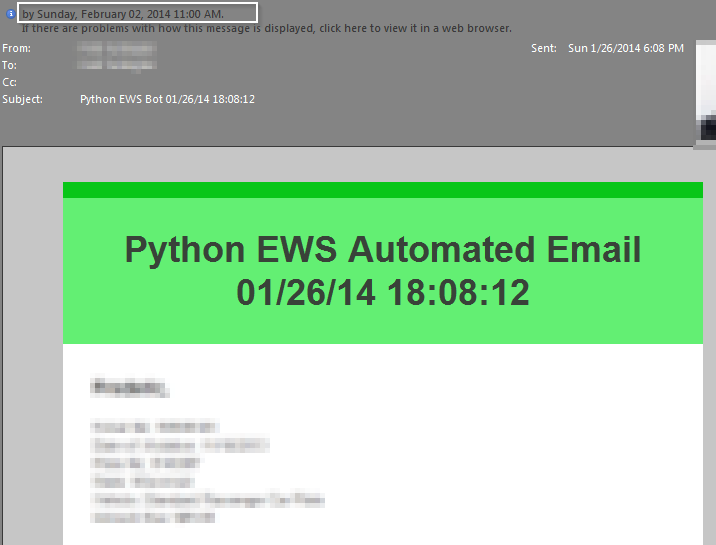Sending an Email on Microsoft Exchange with Python
27 Jan 2014Part 2: Getting the Python EWS Client to Send an Email
Now that I’ve got a client connect to the Exchange server, I can actually use the SOAP API methods as documented in the WSDL and on Microsoft’s documentation.
Suds has great built-in methods and classes for working with SOAP, but as this post confirms, bugs in both Suds and EWS mean that I’ll have to manually build the XML and inject it directly into the message.
So far, I have code that will connect a Suds client to my exchange server and send an XML message:
import ewsclient #Changes to Suds to make it EWS compliant
import ewsclient.monkey # More Suds changes
import datetime
import os
import sys
import suds.client
import logging
import time
from suds.transport.https import WindowsHttpAuthenticated
#Uncomment below to turn on logging
#logging.basicConfig(level=logging.DEBUG)
#Logging on/accessing EWS SOAP API
domain = 'exchange server'
username = r'DOMAIN\username'
password = 'password'
transport = WindowsHttpAuthenticated(username=username,
password=password)
client = suds.client.Client("https://%s/EWS/Services.wsdl" % domain,
transport=transport,
plugins=[ewsclient.AddService()])
#Now that the SOAP client is connected to EWS, send this XML soap message
client.service.CreateItem(__inject={'msg':xml})Now, we just need to tell it what to send in that message.
Building the XML Message
There are all kinds of things you can talk to EWS about, but I just want to talk about emails.
I started with a template message from Microsoft and changed a few things.
First, I wanted to place a copy in my SentItems folder, so I added
<SavedItemFolderId>
<t:DistinguishedFolderId Id="sentitems" />
</SavedItemFolderId>In my first iteration, I had the body sent as text but I wanted to replace it with an HTML email template to make it prettier. This was tough for me to figure out; I kept getting XML validation errors. Eventually, I learned about CDATA, a tag that tells the XML parser to ignore whatever’s inside it.
I replaced the Body tag with:
<t:Body BodyType="HTML"><![CDATA[#Body#]]></t:Body>And will replace the #Body# with some HTML from an email template later. Lastly, I put in some information about an automatic Reminder to get the final message:
<?xml version="1.0" encoding="utf-8"?>
<soap:Envelope xmlns:soap="http://schemas.xmlsoap.org/soap/envelope/"
xmlns:t="http://schemas.microsoft.com/exchange/services/2006/types">
<soap:Body>
<CreateItem MessageDisposition="SendAndSaveCopy" xmlns="http://schemas.microsoft.com/exchange/services/2006/messages">
<SavedItemFolderId>
<t:DistinguishedFolderId Id="sentitems" />
</SavedItemFolderId>
<Items>
<t:Message>
<t:ItemClass>IPM.Note</t:ItemClass>
<t:Subject>Python EWS Bot #SubjectDate#</t:Subject>
<t:Body BodyType="HTML"><![CDATA[#Body#]]></t:Body>
<t:ReminderDueBy>#ReminderDate#T11:00:00-06:00</t:ReminderDueBy>
<t:ReminderIsSet>1</t:ReminderIsSet>
<t:ReminderMinutesBeforeStart>180</t:ReminderMinutesBeforeStart>
<t:ToRecipients>
<t:Mailbox>
<t:EmailAddress>email@domain.com</t:EmailAddress>
</t:Mailbox>
</t:ToRecipients>
<t:IsRead>false</t:IsRead>
</t:Message>
</Items>
</CreateItem>
</soap:Body>
</soap:Envelope>Each of those #Variable# tags I put in the XML will be string-replaced on the Python side.
Putting Variables into the Message
I wrote a quick little function to take a list of tuples and a template text and replace the text in the template:
#Replacing the text in the XML SOAP message
def xmlreplace(text,list):
for i in list:
if i[0] in text:
text = text.replace(i[0],str(i[1]))
return text
#Make a string out of the current time
curdatetime = time.strftime("%c")
#Set the Reminder Date for one week from today
reminderday = datetime.date.today()+datetime.timedelta(days=7)
#Open an HTML file to use as the body
template = (open(file, 'r'))
body = template.read()
#List of parameters in the XML to replace: (template, replacement).
xmlparams=[('#SubjectDate#',curdatetime),('#Body#', body),('#ReminderDate#',reminderday)]
# Replace everything in the XML template shown above with the new dynamic values
xml = xmlreplace(xmltemplate,xmlparams)Now that I have XML as a big string, I can send my message:
